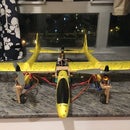Introduction: Binary Clock ++
This instructable is not freshly made, I follow the link from https://www.instructables.com/id/LED-Binary-Clock-1/ , every credit should be given the originator. I finished the project found it's hardly to tell time in the darkness even the LED are lit, especially there are one or two lit, even there are none. No problem under the room light, the major problem is to identify the binary digit, its reference location is important, especially using symbolic mean, i.e. LED on for 1, off for 0, otherwise using digital code 1010 will much better.
Step 1: Add More LEDs
So I decide to present the digit 0 but not simply LED off, I used red and green LEDs, i.e. red for 1 and green for 0, so in the darkness I can easily tell the hour and minute readings.
Step 2: LEDs State Switch
From the original the LED was series a resistor to the output pin, there are only two states. high or low, but no negative, how can I switch the LED? finally I tried the connection in the picture that works, I used square type LEDs that can be compacted together look like a single piece.
Step 3: Modify the Code
According to the original code, the midnight representation is 00:00, so every LED is off, you may wonder if power failure? after adding the green LEDs there will not total off state. I also want to preserve the traditional analogue clock to have the 12 o'clock (in the 12 hours code), so I modify the code a little bit.
After one or two days testing, I found it was lagging the standard time about 2 minutes, so I increase the millis() to 998 ticks and found it almost aligning.











